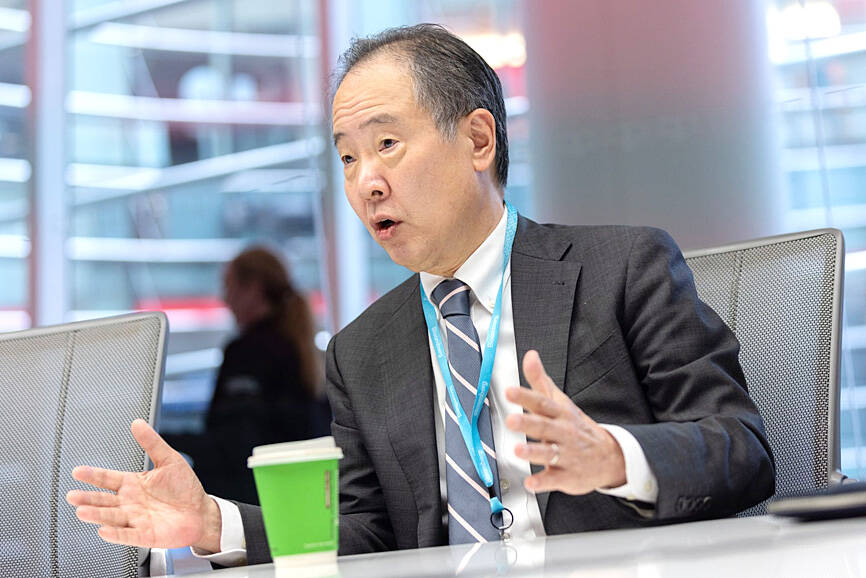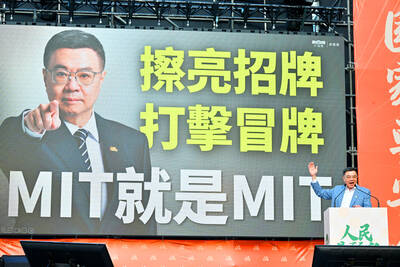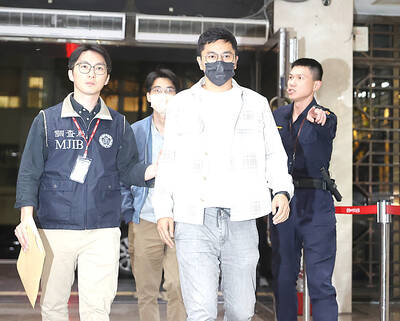The US and allies must balance sending a clear message to China over Taiwan with the need to avoid escalation as Asia enters a “sinister period” of tensions, Japan’s top envoy to the US said.
“We need to respond, we need to send a clear message,” Japanese Ambassador to the US Koji Tomita said in an interview on Tuesday at Bloomberg’s New York headquarters. “We have to act firmly, but wisely, because we have to be careful that we should not go to into an escalatory cycle.”
Tomita said China sought to use US House of Representatives Speaker Nancy Pelosi’s visit to Taiwan earlier this month as a “pretext to do something very aggressive” and change the “status quo” in the Taiwan Strait, launching missiles that landed in the waters of Japan’s exclusive economic zone.

Photo: Bloomberg
Japanese National Security Secretariat Director-General Takeo Akiba raised the issue in a conversation with Chinese State Councilor Yang Jiechi (楊潔篪) on Thursday last week that stretched for about seven hours, Tomita said.
Even as the region is “going into a rather sinister period,” with tensions soaring after Pelosi’s visit, China is entering a “delicate period” before an important Chinese Communist Party meeting in which Chinese President Xi Jinping (習近平) is expected to be given a third term in power, Tomita said.
“In the coming weeks, we need to exercise caution in the hope of managing the situation,” he said. “But at the same time we need to continue our efforts in the context of our alliance cooperation. We need to step up efforts to upgrade our deterrence and capabilities.”
His remarks came as a number of foreign delegations visited Taiwan this month, despite the fierce objections of Beijing.
“There’s no reason why those people should not go to Taiwan, given the importance of Taiwan in the geographical environment, and in the context of industrial production and cooperation with chips,” he said.
Two US lawmakers who were part of a five-member delegation that visited Taiwan last week said the US must maintain close ties with Taiwan and deter China from intervening in the nation without altering the “status quo” in US-China relations.
US Representative Don Beyer said he and the delegation affirmed their support for the US’ long-standing “one China” policy.
“We felt it was important to reinforce the message that despite America’s — or perhaps because of — America’s ‘one China’ policy that we nevertheless wanted to maintain the status quo in Taiwan and deter if possible any kind of forceful intervention that the PRC [People’s Republic of China] would have with Taiwan,” Beyer said on Bloomberg Television’s Balance of Power with David Westin.
On their two-day trip to Taiwan, the delegation met with President Tsai Ing-wen (蔡英文), Minister of Foreign Affairs Joseph Wu (吳釗燮) and Taiwanese lawmakers.
US Senator Ed Markey, who led the delegation, told a news conference on Tuesday that the US has a responsibility to stand with Taiwan and to take a steady approach to avoid escalating tensions.
He rejected assertions by Chinese officials that he and the others were being provocative.
“No one tells me where to stand, and no one tells me where to travel,” Markey said.
“It is imperative that we keep our relations strong with the Taiwanese government. But we cannot respond in kind to Chinese escalation and it’s our moral responsibility to do everything we can to maintain peace, stability and deterrence across the Taiwan Strait,” he said.

Seventy percent of middle and elementary schools now conduct English classes entirely in English, the Ministry of Education said, as it encourages schools nationwide to adopt this practice Minister of Education (MOE) Cheng Ying-yao (鄭英耀) is scheduled to present a report on the government’s bilingual education policy to the Legislative Yuan’s Education and Culture Committee today. The report would outline strategies aimed at expanding access to education, reducing regional disparities and improving talent cultivation. Implementation of bilingual education policies has varied across local governments, occasionally drawing public criticism. For example, some schools have required teachers of non-English subjects to pass English proficiency

‘FORM OF PROTEST’: The German Institute Taipei said it was ‘shocked’ to see Nazi symbolism used in connection with political aims as it condemned the incident Sung Chien-liang (宋建樑), who led efforts to recall Democratic Progressive Party (DPP) Legislator Lee Kun-cheng (李坤城), was released on bail of NT$80,000 yesterday amid an outcry over a Nazi armband he wore to questioning the night before. Sung arrived at the New Taipei City District Prosecutors’ Office for questioning in a recall petition forgery case on Tuesday night wearing a red armband bearing a swastika, carrying a copy of Adolf Hitler’s Mein Kampf and giving a Nazi salute. Sung left the building at 1:15am without the armband and apparently covering the book with a coat. This is a serious international scandal and Chinese

TRADE: The premier pledged safeguards on ‘Made in Taiwan’ labeling, anti-dumping measures and stricter export controls to strengthen its position in trade talks Products labeled “made in Taiwan” must be genuinely made in Taiwan, Premier Cho Jung-tai (卓榮泰) said yesterday, vowing to enforce strict safeguards against “origin laundering” and initiate anti-dumping investigations to prevent China dumping its products in Taiwan. Cho made the remarks in a discussion session with representatives from industries in Kaohsiung. In response to the US government’s recent announcement of “reciprocal” tariffs on its trading partners, President William Lai (賴清德) and Cho last week began a series of consultations with industry leaders nationwide to gather feedback and address concerns. Taiwanese and US officials held a videoconference on Friday evening to discuss the

PERSONAL DATA: The implicated KMT members allegedly compiled their petitions by copying names from party lists without the consent of the people concerned Judicial authorities searched six locations yesterday and questioned six people, including one elderly Chinese Nationalist Party (KMT) member and five KMT Youth League associates, about alleged signature forgery and fraud relating to their recall efforts against two Democratic Progressive Party (DPP) legislators. After launching a probe into alleged signature forgery and related fraud in the KMT’s recall effort, prosecutors received a number of complaints, including about one petition that had 1,748 signatures of voters whose family members said they had already passed away, and also voters who said they did not approve the use of their name, Taipei Deputy Chief Prosecutor